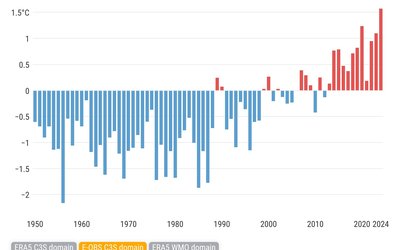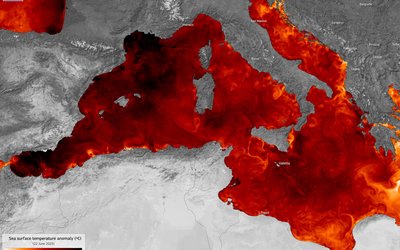Half of the increased heat wave intensity linked to largest fossil fuel companies
October 1, 2025

Photo: Oil terminal at port of Barcelona (source: Marcel Sala, www.flickr.com)
Likelihood heatwaves increases
Worldwide, climate change has made the heatwaves of the past two decades more likely and more intense. This conclusion was drawn from an analysis of 213 heatwaves across 63 countries reported over 2000–2023. The contribution of climate change to the likelihood of these events is also increasing since 2000.
The heatwaves during 2000–2009 became about 20 times more likely since the late 19th century, the time before greenhouse gas emissions from human activities began to change the climate. The heatwaves during 2010–2019 became about 200 times more likely. These figures are median values of the likelihood changes of all heatwaves in a given period. This means that for 50% of the heatwaves during 2010–2019, the change in likelihood was more or less than 200 times, respectively.
Climate change has made 55 heatwaves out of 213 (26%) at least 10,000 times more likely. This means that one-quarter of the heatwaves in the last two decades were virtually impossible without climate change.
Intensity heatwaves increases
Climate change has also increased the intensity of heatwaves. Since the late 19th century, climate change has increased the intensity by 1.4 °C for the heatwaves in the 2000–2009 period, by 1.7 °C for the heatwaves during 2010–2019, and by 2.2 °C for the heatwaves since 2020. Again, these are median values for all heatwaves in a given period.
Large contributions from carbon majors
The authors of this study estimated to what extent major fossil fuel companies – carbon majors – contributed to these increases in the likelihood and intensity of recent heatwaves. They assessed how much the emissions of the 180 biggest carbon majors, during the full value chain of their products, contributed to global warming and to the likelihood and severity of these heatwaves. Altogether, the emissions – carbon dioxide (CO2) and methane (CH4) – from these carbon majors represent 57% of the total cumulative anthropogenic emissions, including land use over the 1850–2023 period.
The authors estimate that 0.67 °C of the 1.30 °C global warming in 2023 is due to the emissions of all 180 carbon majors. In their estimates, 0.33 °C is due to the emissions of the 14 biggest carbon majors, including the world’s largest oil companies such as ExxonMobil, Saudi Aramco and Shell.
50% traced back to 180 carbon majors
48% of the 1.4 °C higher heatwave intensity during 2000–2009, compared with the late 19th century, is traced back to the 180 carbon majors. 32% is traced back to the 14 biggest carbon majors. For the 2010–2019 period, these figures are 50% and 28%, respectively. The world’s 180 largest greenhouse gas emitters contributed to about half of the increase in intensity of heatwaves since preindustrial times. This contribution is rising.
All these companies contributed substantially to the occurrence of heatwaves in the past two decades. In fact, dozens of these heatwaves would have been virtually impossible without the contribution of these businesses.
Source: Quilcaille et al.., 2025. Nature 645: 392-398.








